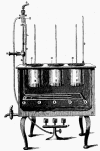What is adaptation by natural selection? Perspectives of an experimental microbiologist
- PMID: 28426692
- PMCID: PMC5398481
- DOI: 10.1371/journal.pgen.1006668
What is adaptation by natural selection? Perspectives of an experimental microbiologist
Abstract
Ever since Darwin, the role of natural selection in shaping the morphological, physiological, and behavioral adaptations of animals and plants across generations has been central to understanding life and its diversity. New discoveries have shown with increasing precision how genetic, molecular, and biochemical processes produce and express those organismal features during an individual's lifetime. When it comes to microorganisms, however, understanding the role of natural selection in producing adaptive solutions has historically been, and sometimes continues to be, contentious. This tension is curious because microbes enable one to observe the power of adaptation by natural selection with exceptional rigor and clarity, as exemplified by the burgeoning field of experimental microbial evolution. I trace the development of this field, describe an experiment with Escherichia coli that has been running for almost 30 years, and highlight other experiments in which natural selection has led to interesting dynamics and adaptive changes in microbial populations.
Conflict of interest statement
The author has declared that no competing interests exist.
Figures



References
-
- Horvath P, Barrangou R. CRISPR/Cas, the immune system of bacteria and archaea. Science 2010; 327, 167–170. doi: 10.1126/science.1179555 - DOI - PubMed
-
- Dobzhansky Th. Nothing in biology makes sense except in the light of evolution. Am Biol Teach 1973; 35, 125–129.
-
- Huxley J. Evolution: The Modern Synthesis. New York: Harper; 1942.
Publication types
MeSH terms
LinkOut - more resources
Full Text Sources
Other Literature Sources

